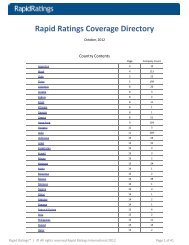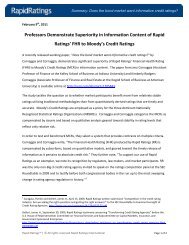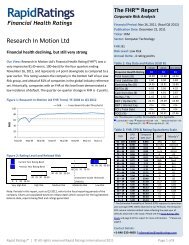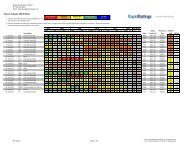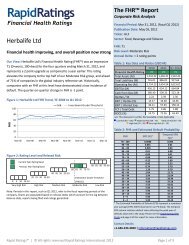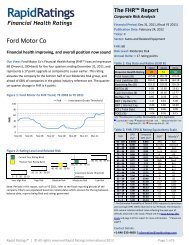Financial Health Ratings Are More Effective than Z ... - Rapid Ratings
Financial Health Ratings Are More Effective than Z ... - Rapid Ratings
Financial Health Ratings Are More Effective than Z ... - Rapid Ratings
You also want an ePaper? Increase the reach of your titles
YUMPU automatically turns print PDFs into web optimized ePapers that Google loves.
Model<br />
Feature<br />
<strong>Financial</strong> <strong>Health</strong> Rating (FHR) and Z‐Score Comparisons<br />
Conclusion: Although various versions of Z‐Score‐type models are still in use today, the effectiveness of<br />
each one is constrained by its inherent limitations. The FHR employs a vastly larger input data set for<br />
calibration, a more robust and pertinent dependent variable, and global industry‐specific models.<br />
<strong>More</strong>over, because FHRs offer significant differentiation between different levels of risk, they are<br />
superior metrics for managing, measuring, and budgeting for financial health risks beyond merely giving<br />
indications of susceptibility to bankruptcy. This is evidenced by the FHR system outperforming the<br />
Z‐Score in terms of accuracy by a identifying 20% more of the cases as well as providing warning signals<br />
about 50% earlier on the average. Both the accuracy and timing tests indicate that <strong>Rapid</strong> <strong>Ratings</strong><br />
provides a significant comparative advantage to lenders, investors and risk managers.<br />
Figure 1: Features Matrix<br />
Z‐Score Model <strong>Rapid</strong> <strong>Ratings</strong> International’s FHR Model<br />
Model type Multivariate discriminant analysis<br />
(linear regression model).<br />
Original model<br />
foundations<br />
Foundation model was based on 66<br />
companies in the US manufacturing<br />
sector, half of which had filed for<br />
bankruptcy. Small firms with assets of<br />
less <strong>than</strong> $1 million were eliminated.<br />
Model inputs 5 FINANCIAL RATIOS<br />
Altman started with 22 financial ratios<br />
but reduced the number to five which<br />
offered the best results:<br />
• Working Capital/Total Assets<br />
• Retained Earnings/ Total Assets<br />
• EBIT /Total Assets<br />
• Market Value of Equity/Total Liabilities<br />
• Sales/Total Assets<br />
Model Outputs Forecasts the relative likelihood of a company<br />
entering bankruptcy within a 2 year period.<br />
Differentiability Tests have shown significant differences between<br />
three groupings or clusters of Z‐Scores, but not a<br />
one‐to‐one relationship with bankruptcy between<br />
a Z‐Score of 2.0 and a Z‐Score of 2.2.<br />
Global<br />
benchmarking<br />
Multivariate Econometric Panel Data Model (non‐linear and adaptive<br />
modeling).<br />
Foundation model was based on 9 million observations drawn from over<br />
300,000 companies from more <strong>than</strong> 30 years from more <strong>than</strong> a dozen<br />
countries. The database contained a large number of small, medium and<br />
large scale companies. These companies were both listed and unlisted.<br />
62 FINANCIAL RATIOS<br />
OPERATING PERFORMANCE<br />
Cost Structure (e.g. COGS/tot. exp.; taxes/revenues)<br />
Profitability (e.g. NPAT/assets; EBIT/capital employed)<br />
Sales Efficiency (e.g. sales/inventories; sales/working capital)<br />
FINANCIAL POSITIONING<br />
Debt Service (e.g. EBIT/interest exp.; interest exp./total liabilities)<br />
Leverage (e.g. total liabilities/sales; total liabilities/total assets)<br />
Working capital efficiency (e.g. working cap./total revenue; term<br />
liabilities/cap. employed)<br />
Assesses the financial health of each company against a very rich global<br />
benchmarking system.<br />
Tests have reflected significant evidence of a one‐to‐one relationship<br />
between FHR level and subsequent incidence of default.<br />
Not employed. This is a fundamental feature of the <strong>Rapid</strong> <strong>Ratings</strong> system that<br />
ensures much more accurate financial performance measurement.<br />
Industry focus Not designed for individual industries Focus on 24 separate industries permits greater precision of risk<br />
measurement and significantly greater forecasting accuracy.<br />
<strong>Effective</strong>ness in<br />
providing early<br />
warning signals<br />
Tests by Eidleman demonstrate greater<br />
<strong>than</strong> 70% reliability in differentiating<br />
companies that go bankrupt within two<br />
years and those that do not.<br />
Test show that 80% of companies that suffer s default event within the<br />
next 12 – 24 months are in the <strong>Rapid</strong> <strong>Ratings</strong> Red Zone of susceptibility to<br />
default defined by an FHR of less <strong>than</strong> 40.<br />
<strong>Rapid</strong> <strong>Ratings</strong> | © All rights reserved <strong>Rapid</strong> <strong>Ratings</strong> International 2008 Page 2 of 2



